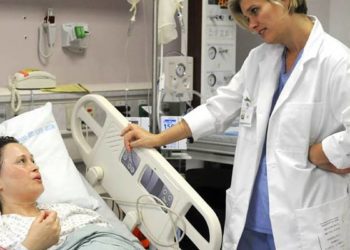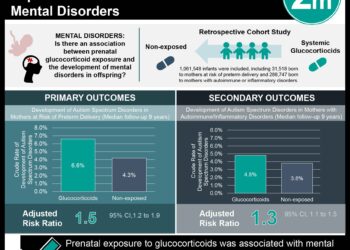2 Minute Medicine Rewind October 23, 2018
β-Blocker use in pregnancy and the risk of congenital malformations: an international cohort study
Beta-blocker medications are commonly used in managing high blood pressure in pregnancy. With an increased prevalence of obesity and related comorbidities in women of reproductive age, exposure to anti-hypertensive medications in early pregnancy has also become more common. The relationship between beta-blocker exposure in utero and the risk of congenital malformations, however, has not been well established. In this cohort study, health registries from the 5 Nordic countries (n=2,310,825) and the US Medicaid database (n=1,358,708) were used to estimate the risks of major congenital malformations associated with first-trimester exposure to beta-blockers in pregnant women with hypertension. Researchers found that women treated with beta-blockers were older than untreated women, more likely to have given birth previously, and were more likely to use anti-hyperglycemic agents. In the US subcohort, women were more likely to smoke and have additional indications for beta-blockers (i.e. migraine, anxiety, arrhythmia, congestive heart failure, ischemic heart disease). The risk of congenital malformations overall was not significantly increased in women using beta-blockers in the first trimester of pregnancy in both the Nordic (RR 1.22, 95% CI 0.88 to 1.71) and US cohorts (RR 1.01, 95% CI 0.80, 1.27). Similar findings were obtained for specific congenital malformations, including cardiac defects and cleft palate. This study was limited due to restricted analysis of live births and exposure based on dispensed medications. Nonetheless, the results of this study indicate that the maternal use of beta-blockers in the first trimester is not associated with a significantly increased risk of congenital malformations.
The administration of anesthetic agents during induction results in a loss of protective upper airway reflexes, and thus may be associated with an increased risk of pulmonary aspiration. While uncommon in elective procedures where fasting rules have been observed, the risk of pulmonary aspiration is significantly increased in emergency settings. In these settings, rapid sequence induction (RSI) is employed to minimize this risk, where a short-acting hypnotic, muscle relaxant, and manual pressure to the cricoid cartilage is applied. The efficacy of RSI, however, has been a subject of debate. In this randomized controlled trial, 3472 patients undergoing anesthesia with RSI with a full stomach (<6 hours fasting) or the presence of at least 1 risk factor for pulmonary aspiration were randomized to a cricoid pressure or sham procedure group to assess whether the incidence of pulmonary aspiration is increased when cricoid pressure is not performed. Researchers found that the rate of pulmonary aspiration did not significantly differ between the groups, where this event occurred in 10 patients in the cricoid pressure group (0.6%) compared to 9 patients in the sham group (0.5%) (RR 0.90, 95% CI 0.33 to 2.38). This study therefore indicates that the application of cricoid pressure during RSI may not reduce the risk of pulmonary aspiration in patients undergoing RSI. Additional studies are needed in other high-risk populations, including pregnant women and patients undergoing RSI outside of the operating room setting.
Bronchiolitis occurs with the viral infection of the lower respiratory tract, carrying with it a significant health burden among young children. According to the American Academy of Pediatrics (AAP) 2014 clinical practice guidelines, routine radiography in the evaluation of infants with bronchiolitis is not recommended, leading to unnecessary radiation exposure, antibiotic overuse and healthcare costs. In this repeated cross-sectional analysis, data from the National Hospital Ambulatory Medical Care Survey (NHAMCS) was used to assess the proportion of infants diagnosed as having bronchiolitis who received radiography in the emergency department between 2007 and 2015. Between 2007 and 2015 there were 612 infants diagnosed with bronchiolitis (median age 8 months). The majority of cases presented to non-teaching, non-pediatric hospitals. Researchers found that the mean proportion of patients diagnosed with bronchiolitis with receipt of radiography was 46.1% (95% CI 39.5% to 52.8%). There was no change in the proportion of infants undergoing radiography by year (OR for year 0.99, 95% CI 0.91 to 1.08, p for trend=0.87). This study therefore shows that there has not been a decrease in radiography in patients with bronchiolitis, despite AAP guidelines, indicating that quality improvement initiatives are needed to translate bronchiolitis guidelines into practice.
Pre-eclampsia and risk of dementia later in life: nationwide cohort study
Pre-eclampsia is defined as new onset hypertension accompanied by signs of organ dysfunction in the setting of pregnancy. Unfortunately, the risks associated with pre-eclampsia extend beyond the time of pregnancy, as affected women are more likely to later develop hypertension, cardiovascular disease, diabetes and experience stroke. As a vascular complication, researchers have hypothesized that the risk of dementia may also be increased in women affected by pre-eclampsia, although data supporting this is limited. In this nationwide register-based cohort study, Danish women with at least one live birth or stillbirth between 197 and 2015 (n=1,178,005) were followed up to explore associations between pre-eclampsia and later dementia. Researchers found that women with a history of pre-eclampsia had a significantly increased risk of vascular dementia later in life (HR 3.46, 95% CI 1.97 to 6.10) when compared to women without a history of pre-eclampsia. This association was stronger for late onset disease (HR 6.53, 95% CI 2.82 to 15.1) than early onset disease (HR 2.32, 95% CI 1.06 to 5.06). Adjustment for cardiovascular disease, stroke, hypertension, chronic kidney disease, and diabetes developing during follow-up attenuated the results, particularly for vascular dementia. However, the associations remained strong and statistically significant. Modest associations were found between pre-eclampsia and Alzheimer’s disease (HR 1.45, 95% CI 1.05 to 1.99) and other dementia (HR 1.40, 95% CI 1.08 to 1.83). This study therefore shows that pre-eclampsia is associated with an increased risk of dementia, particularly vascular dementia.
Gout is the most common inflammatory-type arthritis worldwide, resulting from the presence of intra-articular sodium urate crystals. In addition to painful gout attacks, resulting inflammation can result in joint damage and subcutaneous nodules. Crucial to lowering a patient’s risk of experiencing recurrent attacks are urate-lowering strategies, through both pharmacotherapy and behavioural modification (i.e. weight management, reducing alcohol intake and dietary intake of purines and fructose). Practically, however, gout management in primary care has long been regarded as suboptimal, with less than half of patients receiving urate-lowering therapy. In patients receiving urate-lowering therapy, adherence is often poor, with the dose received being typically fixed without titration to achieve a target serum urate concentration. This is likely the result of misconceptions surrounding the disease (i.e. it is not a serious condition) and a lack of patient education. In this randomized controlled trial, 517 patients who had experienced a gout flare in the previous 12 months were randomized to receive nurse-led care, where individualized information was provided and patients were engaged in shared decision-making, or to continue with usual care. The aim of this study was to compare the efficacy of this nurse-led intervention in gout management when compared to usual care over a 2-year period. Based on multiple imputation, researchers found that after 2 years of follow-up, 95% of patients in the intervention group achieved serum urate concentrations <360 umol/L, compared to 30% in the usual care group (RR 3.18, 95% CI 2.42 to 4.18). Concentrations <300 umol/L at 2 years were seen in 88% of patients in the intervention group, compared to 17% in the usual care group (p<0.0001). In addition, 96% of patients in the intervention group were using urate-lowering therapy at 2 years, compared to 56% of patients in the usual care group, with the most commonly used agent being allopurinol. The mean dose at 2 years in the intervention group was 460 mg/day as compared to 230 mg/day in those receiving usual care. Gout flare frequency reduced gradually from baseline to 2 years in both groups (p<0.0001). Interestingly, the risk of having two or more flares per year was higher in the nurse-led group than in the usual-care group at 1 year, however, this number was considerably reduced after 2 years. This study therefore shows that gout management can be significantly improved with the addition of nurse-led, individualized, patient education and patient engagement in shared decision-making around care.
Image: PD
©2018 2 Minute Medicine, Inc. All rights reserved. No works may be reproduced without expressed written consent from 2 Minute Medicine, Inc. Inquire about licensing here. No article should be construed as medical advice and is not intended as such by the authors or by 2 Minute Medicine, Inc.





![Gene therapy targets Duchenne muscular dystrophy in new trial [PreClinical]](https://www.2minutemedicine.com/wp-content/uploads/2018/10/70_lores-75x75.jpg)

